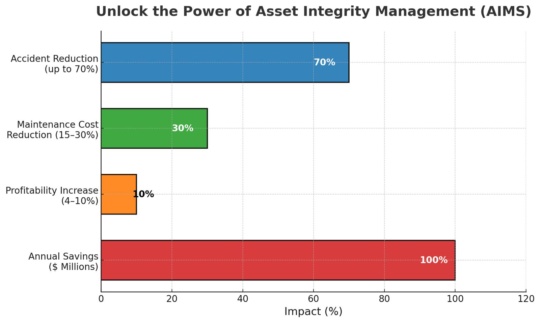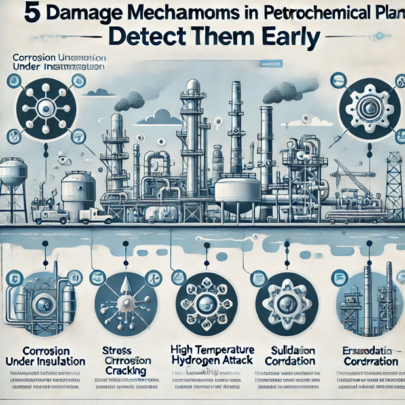
Unlocking Safety, Reliability, and Profitability through Asset Integrity Management Systems (AIMS)

Unlocking Safety, Reliability, and Profitability through Asset Integrity Management Systems (AIMS)
In petrochemical plants, equipment like piping, vessels, and heat exchangers operate under harsh conditions that slowly degrade their integrity. Without early detection, these issues can lead to unplanned shutdowns, environmental risk, and massive repair costs.
Based on API 571, here are five of the most critical damage mechanisms affecting fixed equipment — and how to detect and manage them early using modern tools like RBLX™.

5 Critical Damage Mechanisms in Petrochemical Plants
🔹 1. Corrosion Under Insulation (CUI)
What it is:
CUI occurs when water penetrates damaged insulation and causes corrosion on the metal surface underneath. It’s often hidden and one of the most underestimated threats.
Where it happens:
How to detect it early:
🔹 2. Stress Corrosion Cracking (SCC)
What it is:
SCC is cracking that occurs due to a specific corrosive environment and tensile stress. It’s often difficult to detect until it leads to failure.
Common types:
Where it happens:
How to detect it early:
🔹 3. High Temperature Hydrogen Attack (HTHA)
What it is:
HTHA is a form of degradation that occurs when hydrogen at high temperatures diffuses into steel and reacts with carbides, causing internal damage.
At-risk range:
Above 400°C (750°F) in high-pressure hydrogen environments
Where it happens:
How to detect it early:
🔹 4. Sulfidation (Sulfidic Corrosion)
What it is:
Sulfidation happens when sulfur compounds in process streams react with metal surfaces, forming sulfides that weaken the structure.
Risk zone:
Between 260°C and 540°C (500°F to 1000°F)
Where it happens:
How to detect it early:
🔹 5. Erosion-Corrosion
What it is:
A combined effect of mechanical wear and corrosion, caused by high-velocity or turbulent flow — especially when carrying solids or vapor-liquid mixtures.
Where it happens:
How to detect it early:
💡 Smarter Damage Management with RBLX™
RBLX™ software supports proactive risk management by aligning with API 571, API 580, and API 581. It enables engineers and inspectors to:
✅ Take Action Before Damage Happens
These mechanisms are predictable and preventable. With the right RBI tools, your team can move from reactive inspections to strategic, cost-saving decisions.
📩 Want to see how RBLX™ can help your facility?
👉 Request a demo at lteng.co.uk/contact or email info@lteng.co.uk
🔑 Keywords for SEO:
🏭 Why Age Matters in RBI
Not all facilities are created equal. When it comes to Risk-Based Inspection (RBI), the age of the plant, condition of its assets, and availability of integrity data can drastically change the inspection strategy.
New facilities often start with limited inspection history but well-documented design and materials.
Older facilities may have legacy systems, undocumented changes, and decades of operation — with corrosion and wear already in progress.
With the right RBI software (like RBLX™), both scenarios can be managed effectively — but the approach must change.
🆕 RBI in New Facilities
New assets offer a clean slate — but that doesn’t mean they’re low-risk.
Key RBI Considerations:
Strategy:
✅ Use API 581 models with conservative assumptions
✅ Define baseline corrosion loops
✅ Install corrosion monitoring devices early
✅ Set shorter initial inspection intervals, extend later based on findings
Role of RBLX™:
🏚️ RBI in Aging Facilities
Older plants present different challenges — and bigger opportunities for inspection savings and safety improvements.
Challenges:
Strategy:
✅ Use actual wall thickness and historical inspection data
✅ Reassess every loop for updated mechanisms (API 571)
✅ Apply semi-quantitative or quantitative RBI
✅ Identify NII opportunities to reduce outage costs
Role of RBLX™:
🔍 Comparison Summary
| Feature/Concern | New Facility | Old Facility |
| History Available | Limited or none | Long but variable |
| Corrosion Known? | Not yet | Likely present |
| Initial Risk Bias | Conservative (data-light) | Reactive or evolving |
| Inspection Method | Default RBI intervals | Data-informed RBI + NII options |
| Role of RBLX™ | Build, track, grow | Integrate, optimize, evergreen |
💡 Real-World Takeaway
Whether your site is 30 weeks old or 30 years old, RBI is essential. But the path to reliability, safety, and cost efficiency must be tailored to:
That’s where a flexible, standards-based platform like RBLX™ makes the difference.
📩 Have a new asset or old facility you want to optimize?
Request a demo: lteng.co.uk/contact
📧 Or email: info@lteng.co.uk
🔍 SEO Keywords:
How plants stay safe, reliable, and cost-effective — and how RBLX™ helps make it happen.
Why Asset Integrity Management Matters
Pipelines, pressure vessels, tanks, and exchangers are the heartbeat of oil, gas, and industrial plants. But they face constant threats: corrosion, cracking, leaks, fatigue, and more.
Asset Integrity Management (AIM) is the structured process of ensuring these critical assets operate safely, efficiently, and without unplanned failures — throughout their entire lifecycle.
Whether you run a new facility or a decades-old plant, AIM is the foundation of:
What’s Included in an Integrity Program?
Effective AIM includes several interconnected systems and practices. Here’s what a typical program looks like — and how they all work together:
RBI is about inspecting based on risk, not just time. It helps prioritize assets that matter most and safely extend inspection intervals for low-risk equipment.
Tools like RBLX™ follow API 580/581 and generate:
An IDMS tracks all inspection results, wall thickness readings, NDT reports, and historical data — all in one system.
In RBLX™, IDMS is integrated directly with RBI, so your inspection decisions are always based on up-to-date field data.
CCD organizes your facility into corrosion loops based on fluid, material, temperature, and more.
This helps you manage corrosion risks and plan inspections smarter.
RBLX™ offers a built-in CCD module with:
NII allows certain inspections to be done without opening equipment — saving time, cost, and risk.
RBLX™ helps determine whether NII is suitable using guidelines from HOIS RP103, and can compare:
IOWs define safe ranges for process parameters like pressure, temperature, flow, and pH.
If these go out of range, it may trigger corrosion or damage.
With RBLX™, you can:
Pipelines require a specialized approach. RBLX™ includes PIMS tools to:
Every asset is exposed to certain threats — from pitting to HTHA.
RBLX™ offers a built-in API 571 DMR engine that:
Why an Integrated Approach Matters
In many companies, each of these components exists — but in separate spreadsheets, folders, or tools. This slows down decision-making and increases risk.
RBLX™ unites them in one platform, helping:
Real Benefits of an AIM System like RBLX™
| Impact Area | Result |
| Safety | Early detection of threats |
| Cost | 20–40% savings on inspections |
| Compliance | API 580/581/571 alignment |
| Efficiency | Less duplication & rework |
| Reliability | Extended asset life |
Ready to improve your integrity strategy?
Request a demo of RBLX™: lteng.co.uk/contact
info@lteng.co.uk
🔍 SEO Keywords Included:
Damage mechanism software API 571